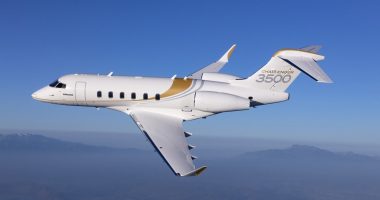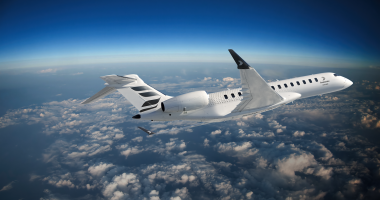Star Navigation bridges the gap between flight experience and flight safety. In the aerospace industry, the Ontario-based aviation safety tech company offers both hardware and software solutions that work in real-time.
The company is gaining real traction with its applications which track performance trends and predict incident occurrence, increasing safety and reliability, while at the same time, reducing the cost to operators.
I’d like to welcome back to the Top Line; Star Senior Director Investor relations Harmeet Singh Gill, and Executive Vice President of Star Navigation and Flight Path International Capt. Jonathan Kordich.
Gentlemen, welcome back.
TMH: A lot has happened for the company since the last time you were both here, and that was pretty recently so, let’s start with your trip through a large part of Africa, five countries where you were promoting your technology. Tell us about the conferences.
JK: It was a tremendous turnout in every place that we went, certainly West Africa. We were pleasantly surprised although we had expectancy for the airline operators to show up the amount of government personnel from the National Civil Aviation Authority in each respective country that actually showed along with their military’s Air Force, Navy, Army and actually police departments, we were very, very pleased with that attendance and above that, the interest that was exhibited by these new potential customers. We did not have that kind of expectancy, but it was certainly very, very welcome.
HG: We started off in Kenya. We had a good number of airlines there, and MRO companies there. We even had KCAA, which is the Kenya Civil Aviation Authorities presence. We had six media outlets that covered the conference, and it was very well perceived, just like Captain said. We went to go see the government in Tanzania right after that and they recently had an accident where 19, unfortunately, people had passed away in this accident that went into Victoria Lake. So, we actually had to cancel our conference over there because of the given circumstances but at the same time we managed to meet the high authorities, the ministers and the commissioners and they were very keen that we come back and do a conference in a few months time, which we are planning to do.
Then we went to Ghana and in Ghana, it wasn’t just the airlines. It was the Air Force, the Navy, and the defense and again, we had the biggest turnout ever at any conference AIB, which is an Aviation Investigation Bureau, was our partner and the Minister for Transportation was there too. Again, it was so well received, they even said that this is the kind of system we need to make a mandate in all of Africa, just to hear them say that in the newspapers and in the media was phenomenal on our side, how important this technology is. Then on our trip to Nigeria, now Nigeria is considered one of the big brothers of Africa. When they make noise, everybody listens, and we had four military presence at this conference. We had the Canadian government represent us in Ghana and in Nigeria from the high commission of Canada and it was great to have their support behind us.
We are a Canadian company, so that’s really brilliant and then the military actually called us in about four other meetings after that and it just kind of gives you to show the technology, how highly it was regarded. I came back from Kenya. Captain was supposed to stay there for one week. We ended up being three weeks for Captain over there to see all the airlines, major airlines, for instance, Air Peace, has 39 aircraft. They were very keen on this and then I went back to Kenya to try to see what I can do with the Canadian government over there and some of the existing clients that we have and new ones coming in. Then we met up at Senegal where again, we met some of the biggest airlines and it was very, very well perceived, as Captain said.
TMH: You were able to parlay that interest into a new Letter of Intent with a Kenyan carrier, unpack that for us.
HG: So it was actually Renegade Air. We signed an LOI I would say about five weeks ago. Renegade Air has got a very sufficient running airline there. It’s well known in the region and they’re actually growing they wanted this kind of system because of past experiences and I’ll give you an example. It’s not more would just Renegade but with any carrier over in that area, usually the plane comes and lands and then they have to give that data that they extracted manually to the I would say the manufacturer and they don’t get the reports back for two, three days and then once they get the reports, it’s in numbers. Now they have to hire a couple of people to actually translate that into plain English and what it means and that could take them another further five days.
So by the time they get all these reports, that plane is still flying and that’s not really in real-time like what Star Navigation does. So that’s why it saves them cost, saves them time and it certainly saves them predictive maintenance, which is what we are keying in on. So these are the things that really hit the right note with Renegade Air we actually have another Zoom call coming up this week and they’re very excited to take this to the next level and that’s one thing that we do. We do give LOI’s and I know a lot of the investor groups have seen quite a few allies coming out that are a letter of intent but at the same time, we do show them the proposal, what kind of prices it is that we can give them. So they’re quite aware of it and we give them a timeline for when to come back and let’s make this a final deal that has really worked well for not only Star Navigation but also for the customer on the other end as well.
TMH: Let’s dig into where some of that positive reaction is coming from. It’s coming from across multiple sectors of aviation.
JK: That is correct. You know to me the biggest success at this point in time was the interest that we were able to generate among the different countries’ military departments. They are Air Force, Army and Navy and particularly the local police departments with helicopters. The interest they exhibited and when we spent some time, particularly in Nigeria with the Nigerian Air Force and Navy as Harmeet mentioned, they started looking at some of our other variants from our in-flight safety monitoring system to be also of great interest and this to me, it’s a major stepping stone in our progression because the impact of military contracts, particularly in the big brother of Africa, which that’s what Nigeria is, that being established with this kind of customer there, it is inevitable then the rest of the countries will follow in that fashion from their governmental departments and certainly, the airlines will do the same.
HG: Just to add to that Simon, as Captain mentioned, we’ve got air, marine and ground. We are actually working on a proposal for one of the militaries right now and they’re interested in all three departments the beauty about it is, is that our ISAMM system the platform itself has helped create a lot of other elements as well, like for the ground vehicles, for the marine vehicles, and also obviously for the air and helicopter vehicles. Now, one thing that Captain is very experienced about, and I would love to put those 2 cents in, is that he did fly for the Canadian armed forces, like for the F-18s, the Hornet planes, he’s flown for Swiss Air. He trains the Triple Seven pilots and 787 pilots as well and he’s got vast experience. So, when he spoke to this military it was almost like buddies, buddies kind of thing that they know each other very well.
They know exactly the pain points, and what they need to expand to help them there and our system because of the security of the data that’s coming in and out. The encryption of the Iridium satellites was really well-liked by the military organization, and I think we hit the right note with them from that, once the military takes it in, it makes it easier for governments to make this kind of system mandated and this is the reason that our system was really, really well-liked by all these groups of people in different sectors as well.
TMH: The calendar year is winding down. What should we expect to see from Star Navigation early in 2023?
JK: Well, that’s a really good question and we all know what the investors want to hear. I mean, we are investors ourselves. We would certainly like to bring the trophy home, but the reality is, this kind of system, they’re not purchased just overnight. It takes some time in terms of assessment, and confidence from the potential customers, but most importantly in this kind of environment is building relationships. So, we have put ourselves on a very solid foundation with that respect and certainly, it is the biggest hurdle in an international business, understanding the local customs from a business perspective, what does it take to get to the next level? Having the relationship, the confidence in our product, in our people from Star Navigation to me is the most significant aspect that we’ve been able to achieve at this point in time.
So that means the next progression here that we are expecting and at least within the first quarter of 2023 is really to get to the next level of commercial arrangements and take it to delivery status. One not-so-desirable situation is that it’s just the nature of the business. Dealing with government agencies always takes a longer time than certainly in private endeavours but our expectancy is that we will get onto the next level with the government agency and private operators. We’re expecting earlier results from the private operators versus the military, but you know, we’ll certainly welcome that it is taking us on the right track to be able to build on that. From a long-term perspective, I would say 2023 will be a very bright year for us and all of our investors.
HG: Just to add to that and Captain said it, he nailed it right ahead. The governments that we had from the Aviation Investigation Bureau, from the ministries from our own Canadian government support that we had in every country that we went to was tremendous. We really felt like royalty. I’ll tell you honestly, the way that the military took us in, they took us as to the lounge, the way we were treated, it was phenomenal. It just gives us a reason to even be more optimistic that this system is really, really needed in Africa, in the market and even when we went to Senegal to the conference, we met the likes of the CEO of Ethiopia Airlines, the CEO of Senegal Air, the CEOs of Mozambique and when these guys saw what we had right away, they invited us.
In fact, Captain was so pushed that even though he wants to have a Christmas break, he’s been pushed to come back the second week of January right after Christmas and even though Captain said, can I come at the end of the month? No, no, we want you now. Why? Before we get too busy, we want to have this approved ASAP with our upper authorities so we can push this through just to have an idea of how big this is and we are very delighted about how 2023 is going to start on the go. You know I’ll answer the next question in a moment but coming from the investor relations side as I am and now that I’m working on the sales side with Captain Jonathan, and it’s been delightful. The partnership that we’ve had with Flight Path has been brilliant and the Captain himself with his vast experience and myself working with the investor groups and everything. With the timeframe I wouldn’t go to sleep till 1:00 AM because I was still talking to investor groups and Captain used to always said, do you ever give up? I go, no. You know what? This is the passion that comes with being in part of the aviation sector.
TMH: What else is important for our viewers and your investors to know right now?
HG: We’re expecting a lot of sales. We’ve had a few LOIs out there. We’ve been working on a few more press releases as well and one of the things that Captain made firm and sure at every conference we went to, was that we are not only looking for clients and customers but are also looking at partners. MRO companies who do maintenance, repair, and overhaul to install our systems on our behalf so we can train them and we are looking at some major players in the market. For instance, in Kenya, you have a company called Helint Aviation. They’re handling about 200 helicopters and they deal with the police force that deals with the Air Force and defense as well and they do fixed-wing planes as well. So that would be an ideal partner to have and that’s one.
Then a few of them others we had was also in Nigeria, in Ghana and these are big boys, they’re well known in the industry, and they were really to the point where they say, you know what? They’ll be delighted to be partners with us in some form or shape and that’s where it was, and I just want to touch a little bit about the LAPSSET project. It’s a 30 billion project in Kenya and that’s moving along really well. We actually met the CEO at the Kenya conference. He actually said some very valuable points there and how delighted it is that he’s got Star Navigation to do the monitoring side of that project and that’s moving ahead very well. So, I mean, I don’t want to leave that one out right now because that’s going to be at the forefront in the coming month or two as well. So, I think you guys will be, as investors will be delighted to see the outcomes of what we’ve achieved on being seven weeks in Africa and what’s about the results that are going to come out of this.
JK: If I may add to that, with respect to the investors, first of all, I’d like to thank all the investors for their faith in us. Our company has had it’s highs and lows just like anybody else, any other kind of business and for the investors to stay with us, we are certainly very, very appreciative and again, thank you. But having said that, we certainly all would like to have a positive outlook but it has to be realistic. What is in front of us to us it is very realistic. It is very achievable. So, my dear investors, don’t cash in your shares, buy some more.
Thanks for coming back to The Market Herald today gentlemen and sharing your insights with our Top Line audience, and your investors.
We’ve been speaking with Star Navigation Senior Director of Investor relations Harmeet Singh Gill, and Executive Vice President of Star Navigation and Flight Path International Jonathan Kordich.
The company trades on the Canadian Securities Exchange under the ticker symbol SNA. You can visit them at star-navigation.com for more information.
FULL DISCLOSURE: This is a paid article produced by The Market Herald.



